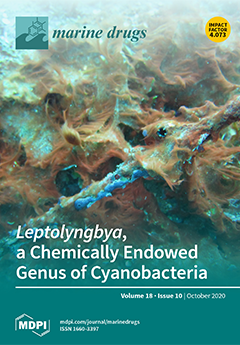Two new nitrogen-containing metabolites, designated hatsusamide A (
1) and B (
2), were isolated from a culture broth of
Penicilliumsteckii FKJ-0213 together with the known compounds tanzawaic acid B (
3) and trichodermamide C (
4) by
[...] Read more.
Two new nitrogen-containing metabolites, designated hatsusamide A (
1) and B (
2), were isolated from a culture broth of
Penicilliumsteckii FKJ-0213 together with the known compounds tanzawaic acid B (
3) and trichodermamide C (
4) by physicochemical (PC) screening. The structures of
1 and
2 were determined as a tanzawaic acid B-trichodermamide C hybrid structure and a new analog of aspergillazines, respectively. The absolute configuration of
1 was determined by comparing the values of tanzawaic acid B and trichodermamide C in the literatures, such as
1H-nuclear magnetic resonance (
1H-NMR) data and optical rotation, after hydrolysis of
1. Compounds
1–
4 were evaluated for cytotoxicity and anti-malarial activities. Compounds
1 and
3 exhibited weak anti-malarial activity at half-maximal inhibitory concentration (IC
50) values of 27.2 and 78.5 µM against the K1 strain, and 27.9 and 79.2 µM against the FCR3 strain of
Plasmodium falciparum, respectively. Furthermore,
1 exhibited cytotoxicity against HeLa S3, A549, Panc1, HT29 and H1299 cells, with IC
50 values of 15.0, 13.7, 12.9, 6.8, and 18.7 μM, respectively.
Full article






